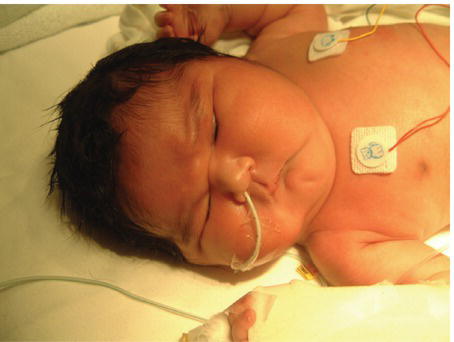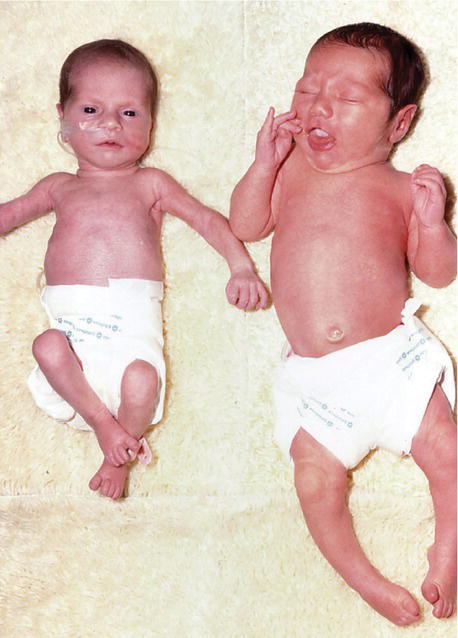45
Hypoglycemia and hyperglycemia
Hypoglycemia
Prolonged symptomatic hypoglycemia can cause neurologic damage. However, during the first few days of life many breastfed infants have low blood glucose levels but are asymptomatic; they are able to utilize ketones and other energy substrates. Therefore, the definition of hypoglycemia in the neonatal period has been the source of considerable controversy.
A serum glucose level of less than 45 mg/dL (<2.6 mmol/L) during the first days of life is currently accepted as a useful cut-off to establish the diagnosis of hypoglycemia and to initiate active evaluation and treatment (Fig. 45.1). Normal newborn infants require 4–5 mg/kg/min (0.22–0.28 mmol/kg/min) of glucose in order to maintain glucose homeostasis.

Fig. 45.1 An example of a guideline for the prevention and treatment of hypoglycemia.
(Adapted from Committee on Fetus and Newborn. Postnatal blood glucose homeostasis in late-preterm and term infants. Pediatrics 2011; 127: 575–579.)
Risk factors
Maternal
- Maternal diabetes mellitus (Fig. 45.2) and obesity.
- Large or rapid infusions of glucose immediately before delivery.
- Maternal β-adrenergic agonist or antagonist therapy.

Fig. 45.2 Macrosomic infant of mother with diabetes mellitus. Maternal hyperglycemia causes β-cell hyperplasia of pancreas and hyperinsulinism in the fetus that lasts for up to 48 hours after birth.
Neonatal
- IUGR (intrauterine growth restriction (Fig. 45.3).
- Small for gestational age (birthweight <10th centile)
- Large for gestational age (birthweight >90th centile).
- Preterm.
- Ill infant – sepsis, etc.
- Iatrogenic – reduced feeds with inadequate intravenous glucose.
- Polycythemia.
- Hypoxic–ischemic encephalopathy (HIE).
- Hypothermia.
- Rhesus disease.

Fig. 45.3 Term twins, the one on the left with IUGR (intrauterine growth restriction). IUGR newborn infants are prone to hypoglycemia.
Causes
Risk factors for transient hypoglycemia are listed above. Persistent hypoglycemia is uncommon; its causes are shown in Fig. 45.4.

Fig. 45.4 Causes of persistent hypoglycemia.
Clinical features
Most are asymptomatic. Clinical features include:
- jitteriness/irritability/high-pitched cry
- depressed consciousness/lethargy/hypotonia
- apnea
- seizures.
Some abnormal physical signs may assist in identifying the cause (Table 45.1).
Table 45.1 Clinical features associated with specific causes of persistent hypoglycemia.
| Clinical feature | Cause |
| Hepatomegaly with or without splenomegaly | Glycogen storage disease, infection |
| Hepatomegaly, large tongue, omphalocele, horizontal ear lobe crease | Beckwith–Wiedemann syndrome |
| Micropenis, hypoplastic optic disk | Panhypopituitarism Need to rule out midline brain defects, e.g. septo-optic dysplasia |
| Lethargy, coma, vomiting, unusual body odor | Hyperammonemia, lactic acidosis, urea cycle disorders or other inborn error of metabolism |
Monitoring
Infants with risk factors should be fed regularly and frequently (at least every 3h) and their blood glucose monitored until it is above 45 mg/dL (>2.6 mmol/L) on two occasions (Fig. 45.1). Blood glucose should not be monitored in appropriately grown term infants establishing breast-feeding. All infants requiring intermediate or intensive care should have their blood glucose monitored.
Blood glucose determination should be performed at the bedside with a glucometer and hypoglycemia confirmed by the laboratory as bedside monitors are not designed to measure low glucose levels accurately.
Investigation
These are performed for persistent or symptomatic hypoglycemia.
Blood tests
- Plasma glucose concentration – true (laboratory) measurement.
- Serum insulin concentration.
If no features of hyperinsulinism (e.g. excessive glucose requirements to prevent hypoglycaemia), check:
- pituitary hormones
- for inborn error of metabolism and acylcarnitine (see Chapter 46).
Other investigations that may be indicated
- Ultrasound of brain and/or MRI – for structural anomaly.
- Ultrasound adrenals – for adrenal hemorrhage.
- Ophthalmologic examination – for septo-optic dysplasia.
Management
Prevention and treatment of hypoglycemia are shown in Fig. 45.1.
Hyperglycemia
No agreed definition, but >125–180 mg/dL (>7–10 mmol/L) on two occasions. Frequent in extremely preterm infants.
Often associated with:
- higher than required rate of IV glucose infusion (>9 mg/kg/min) from dextrose infusion or parenteral nutrition
- sepsis (often associated with fungal infections)
- corticosteroid therapy (high doses) or cortisol response to stress
- insufficient insulin secretion – neonatal diabetes (rare).
Management – check infusion rates, then treat cause or administer insulin therapy (but avoid hypoglycemia).